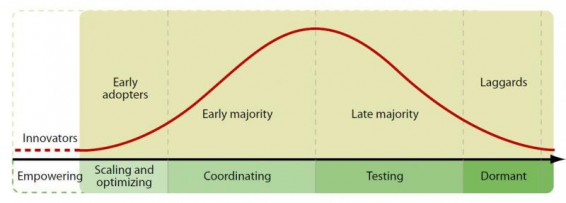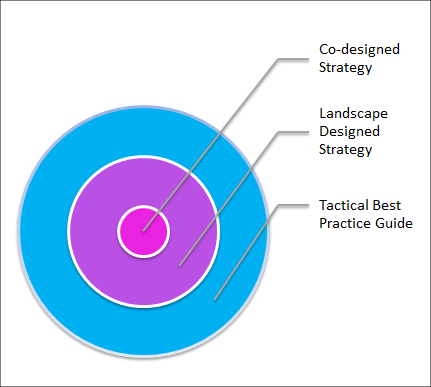Volledige integratie binnen de organisatie grootste uitdaging van social media

Social Media staat nog in de kinderschoenen, dit was de conclusie van Forrester’s onderzoek Accelerating Your Social Maturity: How To Move From Social Experimentation To Business Transformation. Het onderzoek leert dat grote organisaties gemeenschappelijke stadia van verandering doorlopen tijdens de adoptie van sociale technologieën. Forrester noemt dit veranderingsproces “Social Maturity”. Er zijn grofweg twee grote uitdagingen waar organisaties tegenaan lopen, de adoptie en de volledige integratie binnen de organisatie.

Deze bell curvel lees je van rechts naar links.
De meeste organisaties vallen binnen de volgende vijf stadia:
- Laggards: the dormant stage.
Forrester estimates that one in five companies is currently not using any social media. These companies tend to be highly conservative, heavily regulated, or just not interested (yes they exist; think non-tech B2B). To get beyond this stage, we recommend that interactive marketers help garner “small victories” – focusing on the best opportunities that can be used as case studies within the organization to get the ball rolling.- Late majority: the testing stage.
While most companies are using social media, it tends to start organically in pockets. This stage can be described as “distributed chaos,” and to move beyond it, we recommend that a senior interactive marketer step up to play the role of “shepherd” to help coordinate efforts across the organization. (It’s important to note that this role is sometimes manifested in a “social media strategist” or similar, but it is not required, as many companies mature successfully through existing interactive marketing teams).- Early majority: the coordinating stage.
At this point, management recognizes the risks and rewards of social media and begins to put the resources and governance in place to create consistency across the organization, from “distributed chaos” to a more centralized approach. To move beyond this stage, we recommend that interactive marketers work with a steering committee made up of key stakeholders to develop a foundation of shared resources, policies, processes, and budget in place for the long term so the focus can shift to optimizing results.- Early adopters: the scaling and optimizing stage.
These leaders (think Starbucks, Best Buy, and Coca Cola) have already coordinated their social organization and are now focusing on optimizing their social media activities – from improved processes to more advanced metrics to integration with other marketing activity. The next big step for this group is to determine who within the organization is best suited for using social applications to solve customer problems (their HEROes) and for the shepherd to help lead the creation of a plan for empowering all relevant employees with social media.- Innovators: empowering their employees.
At this stage, all relevant employees have been trained and empowered to use social media – essentially “organized distribution” – though centers of excellence are still needed. Only a few companies have even just entered this stage (think Zappos.com) but we expect many more to follow over the course of the next year.
Social Media uitdagingen: adoptie en aanpassing
Wanneer we naar de vijf stadia en de uitleg lezen, kunnen ze opgesplitst worden in twee groepen. De Laggards en Late Majority doorstaan de proef van Social Media adoptie in de organisatie, het begrijpen van de kracht ervan en hoe deze de organisatiedoelstellingen kunnen ondersteunen en behalen.
De Early Majority, Early Adopters en Innovators hebben de adoptie-proef al doorstaan. Zij treffen een nog grotere uitdaging, namelijk continue aanpassingen van strategie, doelen en benutting van het volledige bereik van toepassingen van sociale technologieën.
De focus van Social Media ligt veelal op Engagement, Sales, Marketing en PR. Dit –alhoewel erg belangrijk- is slechts een deel van de mogelijkheden. Denk aan marktonderzoek/klantenonderzoek, new product development, R&D, innovatie, M&A, competitive intelligence enz. Ook de wezenlijke aanpassing van processen, personen(training, beleid) en (overige) technologieën zijn noodzakelijk om deze een integraal deel te laten zijn van de organisatie. Behoeft elke afdeling wel Social Media implementatie? Komt dat naar voren uit Social Media data analyse?
Waarom gebrek aan effectiviteit?
Uit onderzoeken is gebleken dat ineffectiviteit van Social Media implementaties een terugkerende fenomeen is. Booz & Co haar onderzoek, gericht op Nederland, concludeerde dat budgetten voor Social Media met 30% gaan stijgen. Tegelijkertijd ontbreekt het aan een strategie en kwantificering. Uit een ander onderzoek bleek dat slechts 25% “echte, tastbare waarde” uit Social Media hebben gekregen. Dit heeft te maken met het meten, en de scope van toepassingen.
Vaak worden er universele best-practice tactieken geïmplementeerd, die niet zijn afgestemd op de organisatie, haar merk, portfolio en doelgroep. Er is één manier waarop Social Media ingezet kan worden in de organisatie, en dat is op haar eigen manier en tempo.

Social Media data bevat de inzichten waarop de organisatie haar Social Media inzet kan bepalen. De “one-size-fits-all” benadering gaat het meest aan zijn doel voorbij.
Er zijn twee manieren om de effectiviteit te verbeteren.
De landscape designed strategy houdt in dat een organisatie op basis van “bottom-up” inzichten uit Social Media haar strategieën bepaalt. Bijvoorbeeld, op basis van de inzichten uit Social Media wordt de communicatieplanning afgestemd, door de afwezigheid of aanwezigheid van klachten wordt er nagedacht over het openstellen van Klantenservice en ga zo maar door. Op basis van de onttrokken inzichten worden actuele en toekomstige initiatieven beter afgestemd op wat de doelgroep wil.
Co-designed strategy gaat nog een stap verder, in deze “fase” co-creëert de organisatie met externe stakeholders de strategie en executie. De klantgerichtheid neemt in beide toe. Er zijn verschillen in gradatie wanneer het aankomt op betere communicatie, producten en services. De snelheid waarmee deze op de markt worden gezet neem toe en de gepaarde kosten dalen wegens kortere en effectievere cycli. In een co-designed benadering zullen deze optimaler zijn, omdat externe stakeholders continue mee ontwikkelen, vermarkten, en de interactie aangaan op de diverse sociale netwerken. Het Social Maturity proces is een mooi uitgangspunt. Ik zou deze verfijnen om voor doel, er één te maken en analyse te doen of er sprake moet zijn van Social Media adoptie, en zoja, in hoeverre is Social Media volledig geïntegreerd.
@Patrick: Daar hoeven we nu dus niet meer naar toe 😉
Ik denk dat op de curve ook de theorie van Geoffrey Moore van toepassing is. In “Crossing the chasm” geeft hij aan dat het niet vanzelfsprekend is dat na de innovators fase automatisch een fase ontstaat waarbij early adopters het “product” oppakken.Daar moet wel het een en ander voor gebeuren. Als de “ravijn” is overgestoken kan de rest van de curve worden afgelopen.
@ John,
Klopt, ook hier spelen consumenten zelf een rol waar de early adopters de early majority weet over te halen, ipv dat een organisatie de Chasm helemaal zelf moet overbruggen.